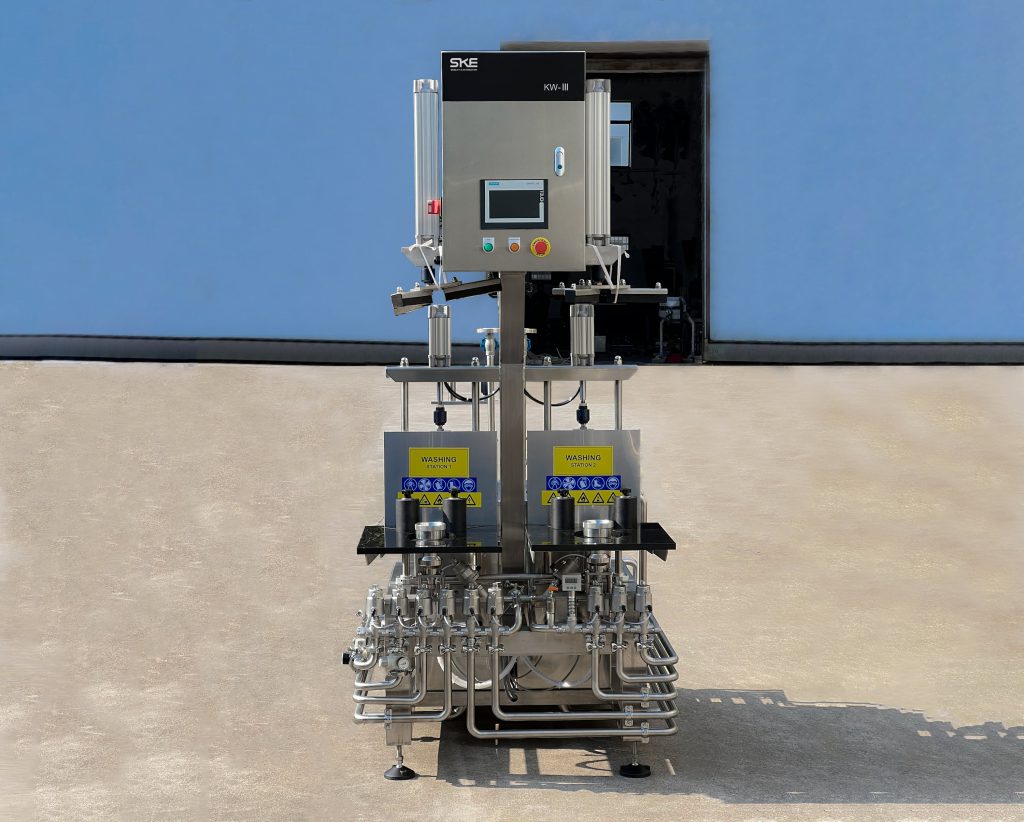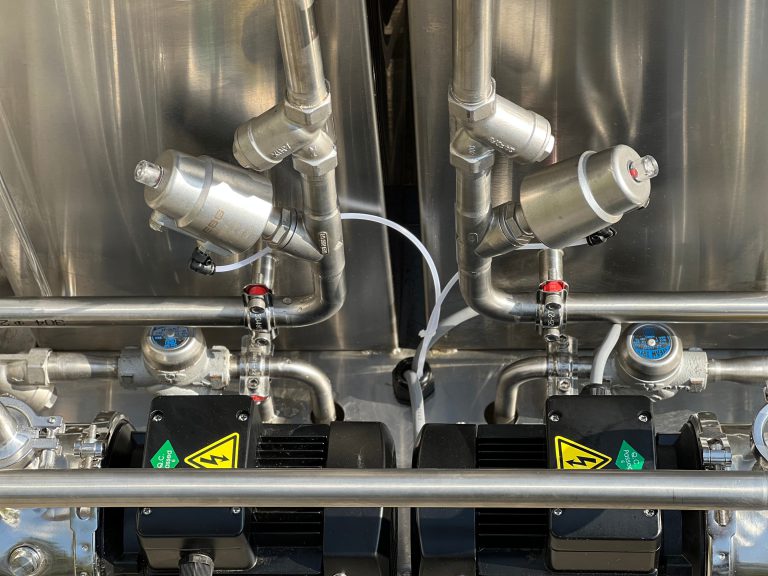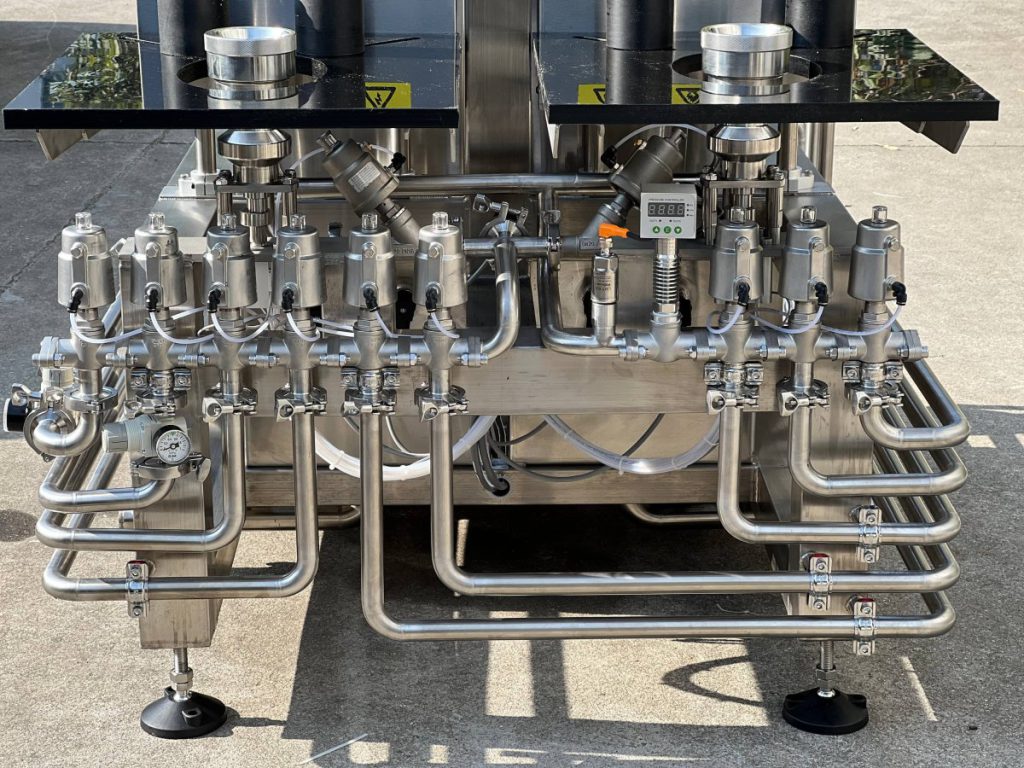Einführung

In der hart umkämpften Braubranche sind Effizienz und Produktivität für das Überleben und den Erfolg von entscheidender Bedeutung. Eine der wirkungsvollsten Investitionen, die eine Brauerei tätigen kann, ist die Fassabfüllanlage. Diese Art von Maschinen verbessert nicht nur den Abfüllprozess, sondern trägt auch zur allgemeinen Betriebseffizienz und Produktivität bei. In diesem Artikel untersuchen wir verschiedene Arten von Fassabfüllanlagen, ihre Vorteile und wie sie die Produktion Ihrer Brauerei steigern können. Darüber hinaus geben wir Einblicke in die Auswahl der richtigen Ausrüstung und deren Wartung für langfristige Vorteile.
Verständnis Fassfüllanlagen
Was ist eine Fassabfüllanlage?
Fassfüllanlagen umfassen eine Vielzahl von Spezialmaschinen und -werkzeugen, die speziell dafür entwickelt wurden, Fässer effizient und gleichmäßig mit Bier zu füllen. Diese Ausrüstung kann von einfachen manuellen Systemen bis hin zu hochentwickelten vollautomatischen Anlagen reichen, die jeweils auf die spezifischen Anforderungen von Brauereien hinsichtlich Größe, Produktionsvolumen und Biersorte zugeschnitten sind. Wenn Brauereibesitzer verstehen, was Fassfüllanlagen beinhalten, können sie deren Bedeutung im Brauprozess besser einschätzen.
Arten von Fassfüllanlagen
Bei der Auswahl einer Fassabfüllanlage ist es wichtig, die verschiedenen verfügbaren Typen zu kennen:
| Typ | Beschreibung | Ideal für |
|---|---|---|
| Manuelle Befüllung | Einfache, arbeitsintensive Systeme für kleine Chargen | Mikrobrauereien |
| Halbautomatisch | Kombiniert manuelle Bedienung mit etwas Automatisierung | Kleine bis mittlere Brauereien |
| Vollautomatisch | Hochleistungssysteme für den Dauerbetrieb | Großbrauereien |
Jeder Typ von Fassabfüllanlage hat einzigartige Vorteile und Einschränkungen. Deshalb ist es für Brauereien wichtig, ihre Wahl an ihren spezifischen Betriebsanforderungen und Produktionszielen auszurichten.
Vorteile einer Investition in Fassfüllanlagen
Verbesserte Effizienz
Der Hauptvorteil moderner Fassfüllanlagen ist ihre Fähigkeit, die Effizienz deutlich zu steigern. Moderne Systeme sind darauf ausgelegt, Fässer schnell und präzise zu füllen, wodurch die für jede Füllung erforderliche Zeit reduziert wird. Diese Effizienz ermöglicht Brauereien nicht nur, ihre Produktionsmengen zu steigern, sondern sorgt auch dafür, dass Mitarbeiter weniger Zeit mit sich wiederholenden Aufgaben verbringen. Beispielsweise kann ein automatisiertes Füllsystem mehrere Fässer gleichzeitig füllen und so den Zeitaufwand für diesen wichtigen Prozess drastisch reduzieren.
Kontinuierliche Qualitätskontrolle
Die Qualitätskontrolle ist ein Eckpfeiler der Brauindustrie, und Fassabfüllanlagen spielen eine entscheidende Rolle bei der Aufrechterhaltung der Konsistenz. Automatisierte Abfüllsysteme minimieren das Potenzial menschlicher Fehler und stellen sicher, dass jedes Fass nach strengen Vorgaben gefüllt wird. Dieses Maß an Konsistenz ist für Brauereien von entscheidender Bedeutung, die ihren Ruf wahren und Qualitätsstandards einhalten möchten. Ein konsistentes Produkt fördert nicht nur die Kundentreue, sondern hilft Brauereien auch, sich auf einem überfüllten Markt abzuheben.
Reduzierte Arbeitskosten
Die Automatisierung der Fassabfüllung kann zu erheblichen Einsparungen bei den Arbeitskosten führen. Durch den Einsatz moderner Abfüllsysteme können Brauereien mit weniger Personal für den Abfüllprozess arbeiten. Dadurch können sich die vorhandenen Mitarbeiter auf andere wichtige Bereiche konzentrieren, wie etwa Qualitätskontrolle, Verpackung oder Bestandsverwaltung. Darüber hinaus verringert sich die Wahrscheinlichkeit von Arbeitsunfällen, wenn weniger Personal für die Abfüllung eingesetzt wird, was wiederum zu Kosteneinsparungen und betrieblicher Effizienz beiträgt.
Geringerer Produktverlust
Einer der oft übersehenen Vorteile moderner Fassabfüllanlagen ist ihre Fähigkeit, Produktverluste während des Abfüllvorgangs zu reduzieren. Viele automatisierte Systeme sind auf Präzision ausgelegt, wodurch Verschütten und Überfüllen minimiert werden. Diese Reduzierung des Produktverlusts ist entscheidend für die Verbesserung der Rentabilität, da in einem wettbewerbsintensiven Markt jede Unze Bier zählt. Darüber hinaus können Brauereien durch die Reduzierung des Abfalls nachhaltigere Praktiken einführen, die bei umweltbewussten Verbrauchern Anklang finden.
Die richtige Wahl Fassfüllanlagen
Zu berücksichtigende Faktoren
Bei der Auswahl der geeigneten Fassabfüllanlage müssen mehrere Schlüsselfaktoren bewertet werden, die den Betriebsanforderungen der Brauerei entsprechen:
- Produktionsvolumen: Um ein geeignetes Abfüllsystem auszuwählen, ist es wichtig, die wöchentlich produzierte Biermenge zu kennen. Großbrauereien benötigen Geräte, die einen hohen Durchsatz bewältigen können, ohne dabei Abstriche bei Qualität oder Effizienz zu machen.
- Budget: Die Bewertung der Investition anhand der erwarteten Erträge und Effizienzgewinne ist entscheidend. Während einige Systeme höhere Anschaffungskosten haben, können die langfristigen Einsparungen bei den Arbeitskräften und die erhöhte Produktion die Kosten rechtfertigen.
- Biersorte: Unterschiedliche Biersorten können spezielle Abfülltechniken oder Gerätekonfigurationen erfordern. Beispielsweise benötigen Handwerksbrauereien, die einzigartige oder Spezialbiere herstellen, möglicherweise anpassbarere Systeme.
- Platzverfügbarkeit: Die räumliche Gestaltung der Brauerei ist ein weiterer wichtiger Aspekt. Für den Betriebserfolg ist es entscheidend, sicherzustellen, dass die ausgewählte Ausrüstung in die Infrastruktur der Brauerei passt und gleichzeitig reibungslose Arbeitsabläufe ermöglicht.
Die Auswirkungen von Fassfüllanlagen zur Produktivität von Brauereien
Optimierter Workflow
Durch Investitionen in Fassabfüllanlagen können die Arbeitsabläufe in einer Brauerei erheblich optimiert werden. Durch die Integration moderner Abfüllsysteme in bestehende Betriebsabläufe können Brauereien häufig ihre Planung verbessern, Ausfallzeiten reduzieren und die Durchlaufzeiten verkürzen. Mit einem vollautomatischen System kann eine Brauerei beispielsweise nahtlos vom Brauen zum Abfüllen übergehen, Leerlaufzeiten minimieren und die Produktivität maximieren.
Fallstudie: Eine erfolgreiche Brauereiumgestaltung
Um die Auswirkungen einer effektiven Fassabfüllanlage zu veranschaulichen, betrachten wir eine hypothetische Fallstudie:
Golden Grain Brauerei stand vor Herausforderungen bei ihrem manuellen Fassabfüllprozess, bei dem täglich etwa 300 Fässer produziert wurden. Häufige Verzögerungen aufgrund von Arbeitskräftemangel und Gerätestörungen behinderten ihr Wachstumspotenzial. Nach gründlicher Recherche und der Auswahl eines halbautomatischen Fassabfüllsystems konnte die Golden Grain Brewery ihre tägliche Produktion auf 600 Fässer steigern. Die Investition verbesserte nicht nur die Konsistenz, sondern reduzierte auch die Arbeitskosten erheblich, sodass die Brauerei Ressourcen für Marketing und Produktentwicklung einsetzen konnte.
Wartung und Instandhaltung von Fassfüllanlagen
Regelmäßige Wartungsanforderungen
Um die Langlebigkeit und Effizienz von Fassabfüllanlagen zu gewährleisten, ist eine regelmäßige Wartung unerlässlich. Die Erstellung eines routinemäßigen Wartungsplans kann dazu beitragen, kostspielige Ausfallzeiten und Geräteausfälle zu vermeiden. Zu den wichtigsten Wartungsaufgaben gehören:
- Tägliche Inspektionen: Überprüfen Sie das Gerät auf sichtbaren Verschleiß oder Fehlfunktionen.
- Wöchentliche Reinigung: Sorgen Sie für Hygiene und verhindern Sie Kontaminationen, indem Sie Komponenten reinigen, die mit Bier in Berührung kommen.
- Monatliche technische Bewertungen: Überprüfen Sie wichtige mechanische Teile auf Anzeichen von Verschleiß, um eine optimale Leistung sicherzustellen.
- Jährliche professionelle Wartung: Durch die Beauftragung eines umfassenden Check-ups durch einen Fachmann können Sie unerwartete Probleme vermeiden und die Lebensdauer der Geräte verlängern.
Häufige Probleme und Lösungen
| Häufiges Problem | Mögliche Ursache | Lösung |
|---|---|---|
| Inkonsistente Füllungen | Verstopfte Düsen | Regelmäßiger Reinigungsplan |
| Geräteausfallzeiten | Mechanisches Versagen | Routinemäßige Wartungskontrollen |
| Hohe Leckageraten | Falsche Druckeinstellungen | Kalibrierung und Schulung |
Durch proaktives Angehen dieser häufigen Probleme mittels regelmäßiger Wartung und umgehendem Handeln können Brauereien Ausfallzeiten erheblich reduzieren und einen reibungslosen Betrieb aufrechterhalten.
Zukünftige Trends in Fassfüllanlagen

Fortschritte in der Technologie
Die Zukunft der Fassabfüllanlagen ist geprägt von Innovationen, wobei technologische Fortschritte zu mehr Effizienz und Effektivität führen. Erwarten Sie Entwicklungen in Bereichen wie der IoT-Integration, die es Brauereien ermöglicht, die Leistung der Anlagen in Echtzeit zu überwachen. Diese Fähigkeit ermöglicht schnellere Reaktionen auf Probleme, was letztendlich die Produktivität verbessert und Ausfallzeiten reduziert.
Überlegungen zur Nachhaltigkeit
Da in der Brauindustrie der Fokus zunehmend auf Nachhaltigkeit liegt, werden künftige Technologien zur Fassabfüllung wahrscheinlich umweltfreundliche Materialien und energieeffiziente Betriebsabläufe beinhalten. Brauereien, die in nachhaltige Lösungen zur Fassabfüllung investieren, können nicht nur ihren CO2-Fußabdruck reduzieren, sondern auch ein wachsendes Segment umweltbewusster Verbraucher ansprechen.
Abschluss
Fazit: In Qualität investieren Fassfüllanlagen ist ein entscheidender Schritt für Brauereien, die ihre Produktivität und Betriebseffizienz steigern möchten. Die Vorteile gehen über Abfüllgeschwindigkeit und -genauigkeit hinaus; sie umfassen geringere Arbeitskosten, verbesserte Produktkonsistenz und geringere Produktverluste. Durch sorgfältige Prüfung der verfügbaren Gerätetypen und Bewertung wichtiger Faktoren während des Auswahlprozesses können Brauereien fundierte Entscheidungen treffen, die zu langfristigem Erfolg und Wachstum in einem wettbewerbsintensiven Markt führen.
Häufig gestellte Fragen
F: Wie wähle ich das richtige Fassfüllanlagen für meine Brauerei?
A: Um die richtige Fassabfüllanlage auszuwählen, müssen Sie Ihr Produktionsvolumen, Ihr Budget und die Platzverfügbarkeit bewerten. Durch die Analyse dieser Faktoren finden Sie die beste Lösung für Ihre betrieblichen Anforderungen.
F: Welche Wartung ist für die Fassabfüllanlage erforderlich?
A: Zur regelmäßigen Wartung gehören tägliche Inspektionen, wöchentliche Reinigungen, monatliche technische Bewertungen und eine jährliche professionelle Wartung. Diese Aufgaben gewährleisten optimale Leistung und Langlebigkeit der Geräte.
F: Kann Fassfüllanlagen Produktqualität verbessern?
A: Ja, automatisierte Systeme reduzieren menschliche Fehler und stellen sicher, dass jedes Fass nach den gleichen Spezifikationen gefüllt wird. Diese Konsistenz ist entscheidend für die Einhaltung hoher Qualitätsstandards beim Brauen.
F: Welche Kosten entstehen durch die Investition in eine Fassabfüllanlage?
A: Die anfänglichen Kosten können zwar beträchtlich sein, doch die langfristigen Einsparungen beim Arbeitsaufwand, der geringere Produktverlust und die höhere Effizienz sorgen in der Regel für eine hohe Kapitalrendite.
F: Gibt es besondere Herausforderungen im Zusammenhang mit der Fassbefüllung?
A: Zu den häufigsten Problemen zählen mechanische Ausfälle, unregelmäßiges Befüllen und hohe Leckageraten. Diese Probleme können oft durch regelmäßige Wartung und entsprechende Schulung des Personals behoben werden.
F: Wie können Brauereien mit Fassabfüllanlagen Nachhaltigkeit gewährleisten?
A: Investitionen in energieeffiziente Technologien und umweltfreundliche Materialien können Brauereien dabei helfen, ihren CO2-Fußabdruck zu reduzieren und gleichzeitig ihre Nachhaltigkeitsbemühungen zu verstärken.
F: Wie sieht die Zukunft von Fassfüllanlagen?
A: Es dürfen Fortschritte bei der Automatisierung, der IoT-Integration und bei Nachhaltigkeitsfunktionen erwartet werden, die die Fassabfülltechnologie in der Brauindustrie weiter revolutionieren werden.

